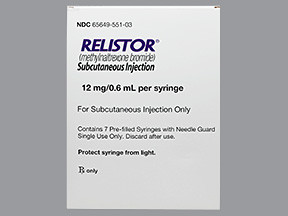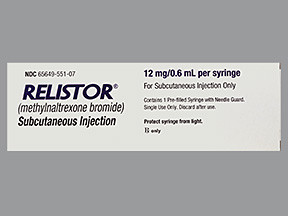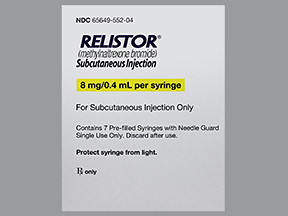METHYLNALTREXONE - INJECTION
PHONETIC PRONUNCIATION: (METH-il-nal-TREX-one)
COMMON BRAND NAME(S): Relistor
GENERIC NAME(S): methylnaltrexone bromide
Uses
USES: This medication is used to treat constipation caused by opioid (narcotic) medication. It blocks the effect of opioids on the gut without blocking the effect on pain. Methylnaltrexone belongs to a class of medications known as opioid antagonists.
How to use METHYLNALTREXONE - INJECTION
HOW TO USE: Read the Medication Guide and, if available, the Patient Information Leaflet provided by your pharmacist before you start using methylnaltrexone and each time you get a refill. If you have any questions, ask your doctor or pharmacist. Inject this medication under the skin in the upper arm, abdomen, or thigh. Your doctor might direct you to use this medication once a day on a set schedule, or direct you to use it every other day as needed. Follow your doctor's instructions carefully. Do not use more than once in 24 hours. Do not inject into a muscle or vein. If you are giving this medication to yourself at home, learn all preparation and usage instructions from your health care professional and the product package. The solution is normally clear and colorless to pale yellow. Before using, check this product visually for particles or discoloration. If either is present, do not use the liquid. Learn how to store and discard medical supplies safely. Before injecting each dose, clean the injection site with rubbing alcohol. It is important to change the location of the injection site with each dose to avoid problem areas under the skin. The dosage is based on your weight, medical condition, and response to treatment. Carefully check that you have drawn the correct dose into the syringe. The markings on the syringe measure the amount of liquid (milliliters/mL), not the amount of medication (milligrams/mg). For example, if your doctor has directed you to use 8 milligrams of medication, draw the liquid up to the 0.4-milliliter mark on the syringe. A 12-milligram dose is 0.6 milliliters. Ask your doctor or pharmacist if you have any questions or if you are not sure how to measure your dose. Ask your doctor if you should continue using your usual medications for constipation. This medication is used only for constipation caused by opioids. Stop using methylnaltrexone when you stop using opioid pain medication unless otherwise directed by your doctor. Make sure you are close to a bathroom after using this medication. This medication works quickly. Most people have a bowel movement within a few minutes to a few hours after using this medication. Tell your doctor if your condition lasts or gets worse.
Side Effects
Precautions
Interactions
Overdose
Images
Reviews
Disclaimer
IMPORTANT: HOW TO USE THIS INFORMATION: This is a summary and does NOT have all possible information about this product. This information does not assure that this product is safe, effective, or appropriate for you. This information is not individual medical advice and does not substitute for the advice of your health care professional. Always ask your health care professional for complete information about this product and your specific health needs.



No Reviews Yet